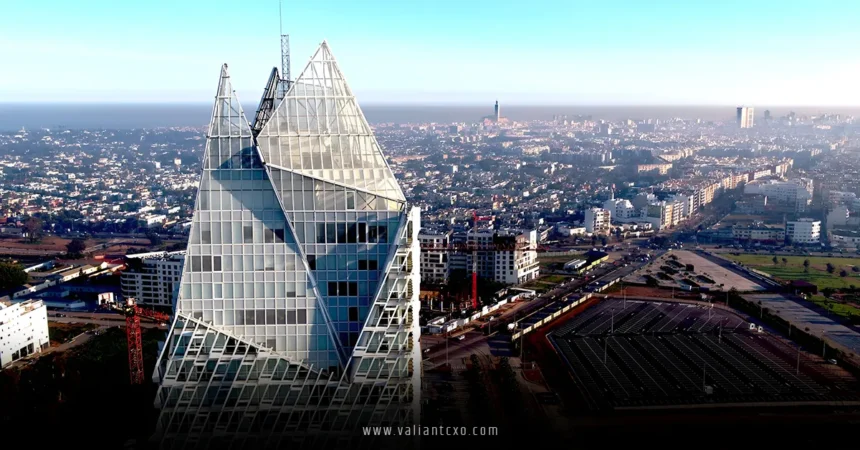Casablanca is more than just a name that sparks images of classic Hollywood romance or bustling North African markets. It’s a vibrant, sprawling city on Morocco’s Atlantic coast, where history, culture, and modernity collide in a mesmerizing dance. Have you ever wondered what makes Casablanca so special? Is it the iconic mosque that touches the heavens, the lively souks, or the whispers of a bygone era captured in its colonial architecture? Let’s take a journey through Casablanca, exploring its rich tapestry of experiences, from its historical roots to its modern-day allure.
Why Casablanca Captivates the Heart
Casablanca isn’t just Morocco’s largest city; it’s the beating economic heart of the nation. With a population of over 3.5 million, it’s a hub of commerce, culture, and creativity. Picture a city where the salty breeze of the Atlantic mingles with the aroma of street food, where skyscrapers cast shadows over centuries-old buildings. That’s Casablanca—a place that feels like a living, breathing paradox, blending the old with the new in a way that’s both chaotic and harmonious.
What sets Casablanca apart from other Moroccan cities like Marrakech or Fez? It’s the city’s ability to wear multiple hats. It’s a financial powerhouse, a cultural melting pot, and a destination that offers something for every traveler. Whether you’re a history buff, a foodie, or someone chasing Instagram-worthy views, Casablanca has a story to tell.
A Brief History of Casablanca
To truly understand Ca-sab-la-nca, you need to know its roots. The city’s history stretches back to the 7th century when it was a Berber settlement called Anfa. Fast forward to the 15th century, and it became a haven for pirates—yep, actual swashbucklers! The Portuguese destroyed Anfa in 1468, only to rebuild it as “Casa Branca” (White House). The name stuck, evolving into Casablanca under Spanish influence. By the 20th century, under French colonial rule, the city transformed into a modern metropolis, with wide boulevards and Art Deco buildings that still define its skyline.
Today, Ca-sa-bl-anca is a symbol of Morocco’s progress, yet it holds tight to its heritage. Walking through its streets, you’ll feel like you’re flipping through a history book, with each corner revealing a new chapter. For a deeper dive into Morocco’s history, explore The British Museum’s Islamic World Collection.
Must-Visit Landmarks in Casablanca
No trip to Ca-sa-bl-anca is complete without exploring its iconic landmarks. These sites aren’t just pretty to look at—they tell the story of a city that’s been shaped by faith, culture, and ambition.
The Hassan II Mosque: A Marvel by the Sea
If there’s one image that defines Ca-sa-bl-anca, it’s the Hassan II Mosque. Perched on the edge of the Atlantic, this architectural masterpiece is one of the largest mosques in the world. Its minaret soars 210 meters, making it the tallest in Africa. What’s jaw-dropping is that part of the mosque’s floor is glass, letting worshippers pray directly above the ocean. How cool is that?
Completed in 1993, the mosque showcases intricate Moroccan craftsmanship, with hand-carved marble, colorful zellige tiles, and cedar wood ceilings. It’s a place where spirituality meets spectacle, and even non-Muslims can visit (a rarity for mosques in Morocco). Trust me, standing in its massive courtyard, with waves crashing nearby, feels like stepping into a postcard.
The Old Medina: A Glimpse of Authentic Casablanca
While Ca-sa-bl-anca’s Old Medina may not be as famous as Fez’s labyrinthine souks, it’s a gem in its own right. This historic quarter is a maze of narrow alleys lined with shops selling everything from spices to leather goods. The energy here is electric—vendors call out, kids dart through the crowds, and the scent of fresh mint tea fills the air. It’s like diving into a sensory whirlpool.
Pro tip: Bargain with a smile! Haggling is part of the fun in Casablanca’s markets. Grab a handmade rug or a pair of babouche slippers as a souvenir, and you’ll feel like you’ve won a small victory.
The Corniche: Casablanca’s Coastal Playground
Looking for a place to unwind? Head to the Corniche, Casablanca’s seaside promenade. Stretching along the Atlantic, it’s lined with cafes, restaurants, and beach clubs. During the day, families stroll and joggers zip by; at night, it transforms into a lively hotspot with music and lights. It’s like Ca-sa-bl-anca’s version of a boardwalk, but with a Moroccan twist—think fresh seafood tagine instead of hot dogs.
The Cultural Soul of Casablanca
Casablanca isn’t just about landmarks; it’s a city with a soul. Its culture is a vibrant mix of Arab, Berber, French, and African influences, creating a unique identity that’s hard to pin down.
Food That Tells a Story
Let’s talk about food—because in Casablanca, it’s a love language. Moroccan cuisine is a feast for the senses, and this city does it best. Start with a steaming bowl of harira, a hearty soup made with lentils, chickpeas, and tomatoes. Then, dive into a tagine, slow-cooked to perfection with lamb, chicken, or veggies, spiced with saffron and preserved lemons. Don’t skip couscous on Fridays—it’s a tradition!
For dessert, try pastilla, a sweet-and-savory pastry that’s like a hug in food form. Wash it all down with Moroccan mint tea, poured dramatically from a height to create that perfect froth. Dining in Casablanca isn’t just eating; it’s an experience that connects you to centuries of tradition. For authentic Moroccan recipes, check out BBC Good Food’s Moroccan Collection.
Art and Architecture: A Visual Feast
Casablanca’s architecture is like a time machine. The French colonial influence is everywhere, from the Art Deco buildings in the Habous Quarter to the grand Place Mohammed V. These structures are a nod to the city’s past as a French protectorate, with elegant facades and intricate details.
But it’s not all old-school. Ca-sa-bl-anca is home to a thriving contemporary art scene. Galleries like Le Loft Art Gallery showcase local talent, blending traditional Moroccan motifs with modern flair. Visiting one feels like stepping into the mind of Casablanca’s creative class.
Modern Casablanca: A City on the Move
Ca-sa-blanca isn’t stuck in the past—it’s a city that’s constantly evolving. As Morocco’s economic engine, it’s home to sleek skyscrapers, tech startups, and a buzzing port. Yet, it retains a warmth that makes you feel at home, no matter where you’re from.
The Business Hub of Morocco
Casablanca’s skyline is dotted with glass towers, home to banks, corporations, and startups. The Casablanca Finance City aims to make the city a gateway for African investment. It’s like Morocco’s Wall Street, but with better coffee and a view of the ocean. If you’re a business traveler, you’ll find world-class hotels and conference centers that rival any global city.
A Shopper’s Paradise
From high-end boutiques to bustling souks, Casablanca is a shopper’s dream. Head to the Morocco Mall, one of Africa’s largest shopping centers, for luxury brands and a massive aquarium. Prefer something more local? The Derb Ghallef flea market is a treasure trove of vintage finds, from retro lamps to handmade jewelry. Shopping in Casablanca is like a scavenger hunt—you never know what gem you’ll uncover.
Experiencing Casablanca Like a Local
Want to live like a Ca-sa-blancan? It’s all about embracing the rhythm of the city. Start your day with a strong coffee at a sidewalk café, watching the world go by. Take a tram ride—Casablanca’s modern tram system is a great way to explore. At night, join locals at a rooftop bar for cocktails and live music. The city’s nightlife is vibrant, with everything from jazz clubs to trendy lounges.
And don’t be afraid to get lost. Wandering Casablanca’s streets, you’ll stumble upon hidden cafes, street art, or a friendly local eager to share their story. It’s these unplanned moments that make Casablanca unforgettable.
Practical Tips for Visiting Casablanca
Planning a trip to Casablanca? Here are some tips to make your visit smooth and memorable:
- Best Time to Visit: Spring (March-May) and fall (September-November) offer mild weather, perfect for exploring.
- Getting Around: Taxis are plentiful, but the tram and ride-sharing apps are convenient and affordable.
- Language: Arabic and French are widely spoken, but English is common in tourist areas. Learn a few Arabic phrases like “shukran” (thank you) to win smiles.
- Safety: Casablanca is generally safe, but stay aware in crowded markets and stick to well-lit areas at night.
For more travel planning resources, visit Lonely Planet’s Morocco Guide for expert advice.
Casablanca in Pop Culture
You can’t talk about Casablanca without mentioning that movie. The 1942 film Casablanca, starring Humphrey Bogart and Ingrid Bergman, put the city on the global stage. While the movie was filmed in Hollywood, it captured the city’s mystique as a place of romance and intrigue. Want to channel your inner Rick Blaine? Visit Rick’s Café, a real-life restaurant inspired by the film, complete with live piano music.
Casablanca’s influence extends beyond the silver screen. Musicians, writers, and artists have long drawn inspiration from its vibrant energy. It’s a city that sparks creativity, whether you’re penning a novel or snapping photos.
Sustainability and Responsible Tourism in Casablanca
As travelers, we have a responsibility to leave Casablanca as beautiful as we found it. Support local artisans by buying handmade goods, and choose eco-friendly accommodations. The Moroccan government is investing in sustainable tourism, with initiatives like solar-powered buildings and beach cleanups.
Conclusion: Why Casablanca Should Be Your Next Destination
Casablanca is a city that surprises at every turn. It’s a place where ancient medinas coexist with modern skyscrapers, where the call to prayer blends with the hum of city life. From the awe-inspiring Hassan II Mosque to the lively Corniche, Casablanca offers a kaleidoscope of experiences that linger long after you leave. Whether you’re drawn by its history, food, or vibrant culture, this coastal gem has something for everyone. So, what are you waiting for? Pack your bags, book that ticket, and let Casablanca steal your heart.
FAQs About Casablanca
What is the best time to visit Casablanca?
Spring and fall are ideal for visiting Casablanca, with mild temperatures perfect for sightseeing. Avoid the summer heat if you prefer cooler weather.
Is Casablanca safe for tourists?
Yes, Casablanca is generally safe, especially in tourist areas. Stick to well-lit places at night and keep an eye on your belongings in crowded markets.
Can non-Muslims visit the Hassan II Mosque in Casablanca?
Absolutely! The Hassan II Mosque is one of the few in Morocco open to non-Muslims. Guided tours are available, showcasing its stunning architecture.
What’s the best way to get around Casablanca?
Casablanca’s trams are efficient and affordable, but taxis and ride-sharing apps are also popular. Walking is great for exploring the Old Medina.
Where can I learn more about planning a trip to Casablanca?
Check out TripAdvisor’s Casablanca Guide for reviews and tips from fellow travelers.
Read More:valiantcxo.com


